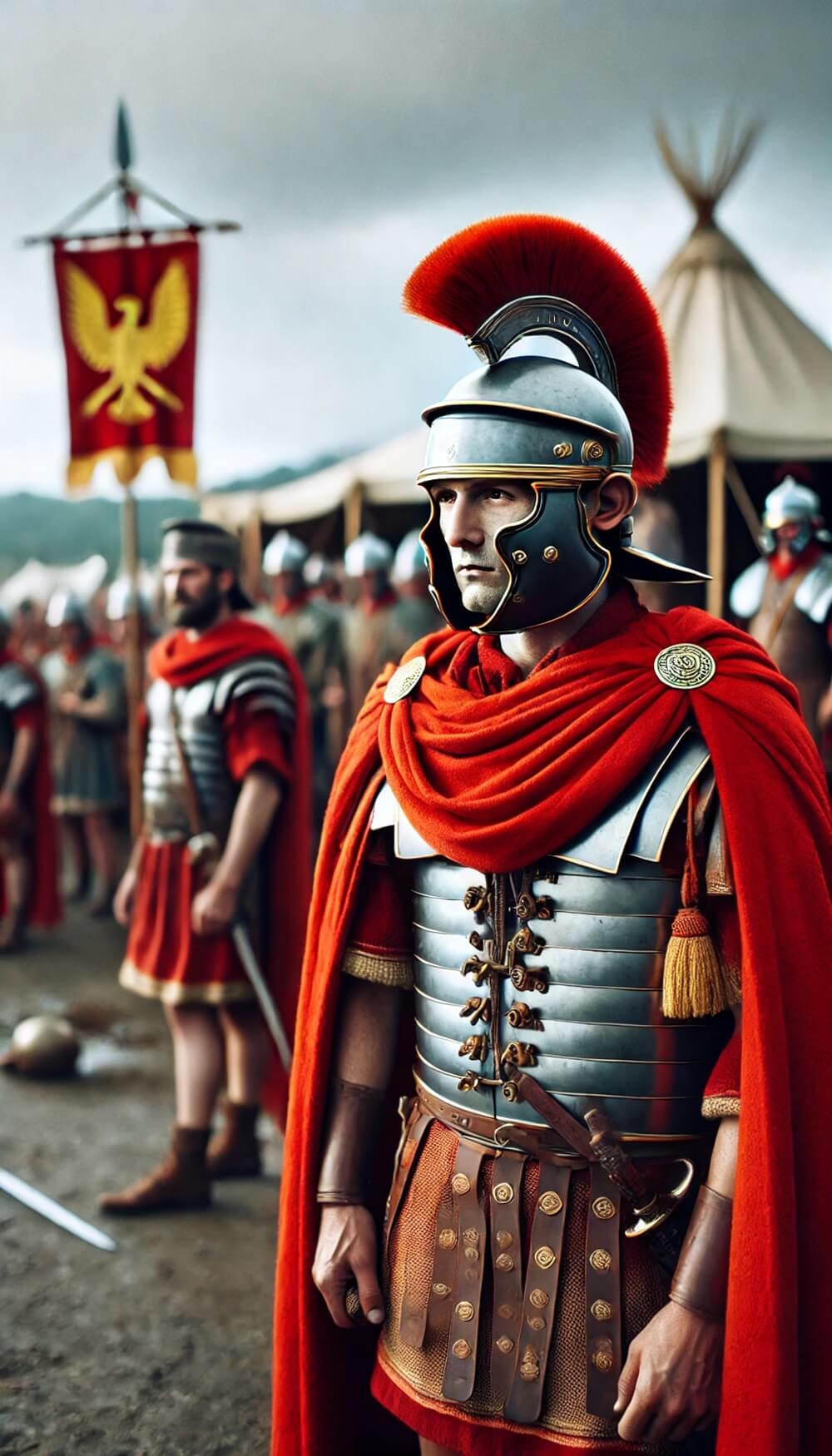The Roman cloak blended practicality with social significance. This garment was not only a means of protection against the elements, but also served as a symbol of status and identity. From the commanding generals to the common citizen, the cloak was a ubiquitous aspect of Roman attire.
Even the Roman legionary, a figure often depicted in the full armor of Rome's military might, would don this garment. For them, it provided warmth during campaigns and signaled his membership within the military ranks.

A Roman soldier wearing a bright red sagum cloak
In civilian life, cloaks were worn by all classes, from the senators to the plebeians, each differentiated by the quality, color, and style, signifying their social standing and profession within the complex hierarchy of Roman society.
Status and Identity: Beyond Mere Warmth
More than a mere fashion statement, the Roman cloak was an essential part of daily life in ancient Rome. Its design and fabric spoke volumes about the wearer, and its functionality extended beyond personal comfort, playing a role in religious ceremonies and public events.
The cloak's durability and versatility made it a staple of Roman culture, demonstrating the empire's ability to merge utility with an understated elegance that has resonated through the ages.
The ancient Roman elite donned cloaks of vivid colors and intricate patterns, often dyed with expensive substances like Tyrian purple, to flaunt their wealth and status. In stark contrast, the common people adorned simpler, undyed garments. Such distinctions in ancient Roman clothing allowed for immediate recognition of social hierarchy.
Roman cloaks varied greatly to suit different occasions. For ceremonies and official events, cloaks were often more elaborate, with elaborate clasps and intricate embroidery. In contrast, everyday cloaks were simpler and more practical.
Materials and Manufacturing
Sourced from across the Roman Empire, the textiles reflected the expansiveness of Roman trade and the skill of its artisans. Wool and linen, the most common materials, were chosen for their availability and suitability to the varied climates under Roman control.
The production of these cloaks was a labor-intensive process, often involving entire communities, from shepherds to dyers, each contributing to the creation of the garment.
Wool and Linen: The Fabrics of Choice
Wool and linen were the favored materials for Roman cloaks due to their warmth and breathability. Wool, sourced from the flocks that roamed the Italian countryside and the provinces, provided insulation during the cooler months. Linen, harvested from flax plants, was valued for its lightness and was often worn during the warmer seasons. Both fabrics were reflections of Rome's agricultural might and its ability to utilize natural resources effectively.
The dyeing process, often using natural dyes extracted from plants, minerals, and insects, was a closely guarded trade secret. The weavers' skill in creating intricate patterns and tightly woven fabrics ensured that the cloaks were not only beautiful but also durable, capable of withstanding the wear and tear of everyday Roman life.
Styling the Roman Cloak: A Guide to Draping and Wearing
Draping a Roman cloak was an art in itself, with styles varying depending on the occasion and status of the wearer. The cloak could be thrown over the shoulder in a casual manner, or arranged in careful folds for a more formal appearance. The manner of wearing this garment reflected the personal style and social position of the individual, with variations signaling everything from fashion to function.
The Clasp and Fibula
The clasp and fibula were not merely functional elements but also important accessories that enhanced the Roman cloak. These fasteners, often elaborately designed and made from materials like bronze, silver, or even gold, secured the cloak in place and added a touch of elegance. The fibula, in particular, could be a statement piece, indicating the wearer's wealth and status.
Roman Cloak Through the Ages: Adaptations and Influences
Over the centuries of the Roman Empire, clothing - including cloaks - underwent various changes, reflecting shifts in fashion, utility, and cultural influences. Initially, Roman cloaks were primarily functional garments designed to protect the wearer from the elements. For example, the sagum was a simple military cloak, while the paenula, a hooded cloak, was common for travel and practical use.
As the Republic transitioned into the Empire, there was a notable shift towards more elaborate and status-driven clothing. The paludamentum, a cloak fastened at one shoulder, became a distinctive garment worn by military commanders and later by emperors, symbolizing authority and command.
Cloaks also became more refined and diverse in style. The birrus or burrus was a heavy woolen cloak, often hooded, that became popular in later periods, especially in the cooler, rainier climates of Northern Europe. Women wore cloaks such as the palla, which was draped over the stola, the traditional garment of Roman women.
Throughout the Empire's evolution, the importance of cloaks as part of state dress increased, particularly during ceremonies involving the Roman Emperors. The changes in Roman cloaks, therefore, mirrored the broader cultural and social shifts of the Empire, from the practicality of the Republic through the luxury and symbolism of the Imperial era.



